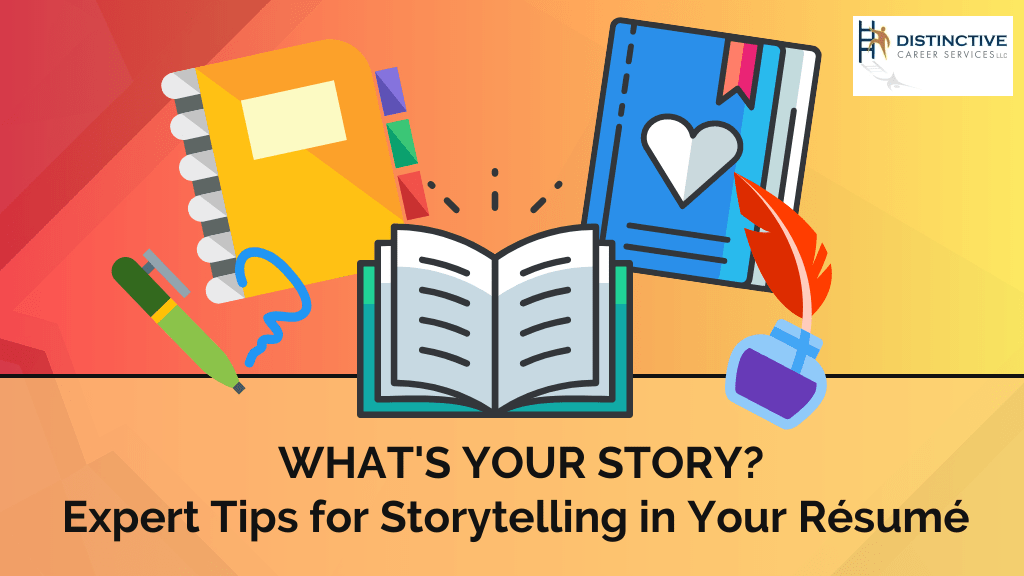What’s your story?
Why should I care?
Storytelling in your resume has a transformative power that almost magically turns a drab, boring resume into an absorbing and persuasive piece that compels the reader to want to meet the real person behind the words.
An effective resume is not merely a collection of words – it is a reflection of a person; a textual compilation describing all aspects of someone’s professional experience, placed on a piece of paper, to be read and reviewed by all potential employers.
One of the problems facing job seekers is that this collection of words has to compete with so many others out there.
Having relevant experience related in a simple reverse chronology isn’t enough anymore.
Your resume needs to tell a story – a cogent, enthralling story – that convinces a potential employer to meet with and ultimately to hire the person behind the resume.
It is your job in your resume to connect the dots, identify the common threads and relationships between your professional and educational experiences, and then pull it all together in a bigger story that illustrates the unique promise of value that you bring to the workplace.
A resume can easily fall flat when there’s a struggle with its words, when it doesn’t tell a story, or doesn’t tell it well.
Who wants to read a poorly written book with an uninteresting plot or unreadable formatting?
A resume is no different. Storytelling in your resume can transform it. And because of the vested interest in the possible results of that resume, creating a compelling story should be of utmost importance.
How can this be achieved? Examining where your resume falls flat is the first step.
The “typical” resume (NOT those written by Distinctive Career Services, of course!) follows a certain autobiographical format: boring job description followed by that job’s responsibilities. When the candidate has held multiple jobs for the same type of position, then the story drones on with repetitive details.
Why should I care?
It’s a crucial question. Put yourself in the shows of the employer and ask “why should they care?”
Your task: Help the reader locate themselves in your story. Begin with the reader in mind. Who are you trying to reach and what is important to that audience?
Consciously or subconsciously, the reader of your resume should easily discern the relevance of your story to their own needs.
Telling a resume story shouldn’t be just a measure of what you did, but also what you have accomplished.
However, accomplishments may lift a reader out of doldrums, but only temporarily.
Accomplishments without context or benefits can leave a reader wondering what was the purpose or impact of that accomplishment in relation to the employer.
A truly effective resume needs to specify the challenges that the candidate experienced, and how they succeeded. For example, a line on a resume can read “Led team that introduced new product to market”. While it’s a valid and accurate description, it won’t get noticed. Nor does it tell a compelling story.
Anchor your resume with data that reinforces your credibility. Just telling a story in your resume isn’t enough. Your story MUST be believable. Try coupling the above statement with a result – “Led team to increase sales 25% by introducing a revolutionary new product to market” – not only indicates what was done, but also provides the validators that make the story of potential that you are telling believable.
Now take the story to the next step. Explain the strategic impact.
An impressive 25% sales increase becomes even more impressive and relevant when it is framed in light of the larger challenge. “Revived stagnant sales and saved the company from imminent bankruptcy by introducing a revolutionary new product to market that propelled sales to a record-setting 25% increase.”
Your story has suddenly become irresistible to a potential employer who is struggling to increase sales and earnings.
When you showcase challenges and highlight results, your resume becomes more action-oriented, and that makes a story compelling and persuasive.
Also, remember that a story isn’t just about words.
Who doesn’t judge a book by its cover at some level?
Likewise for your resume. The formatting can be strategically designed to accentuate parts of your story that will be of particular interest to the potential employer. For example, shaded boxes not only highlight key points, but also make the appearance more intriguing.
Selective bolding can be used to call out results. But too much and a story becomes overwhelming. Use design elements sparingly but make them count.
A storyteller can take an everyday story, and through voice, expression, words, and gestures, transfix an audience to hang on every word. Using different tools but the same concept, storytelling in your resume can do the same thing with extraordinary results.
Are you struggling to implement storytelling in your resume? Do you want help transforming your resume with your unique stories? You don’t need to struggle on your own. Book a free discovery consultation with us today and let us write your resume for you.
Updated from a post originally published on this blog Apr 29, 2015.










